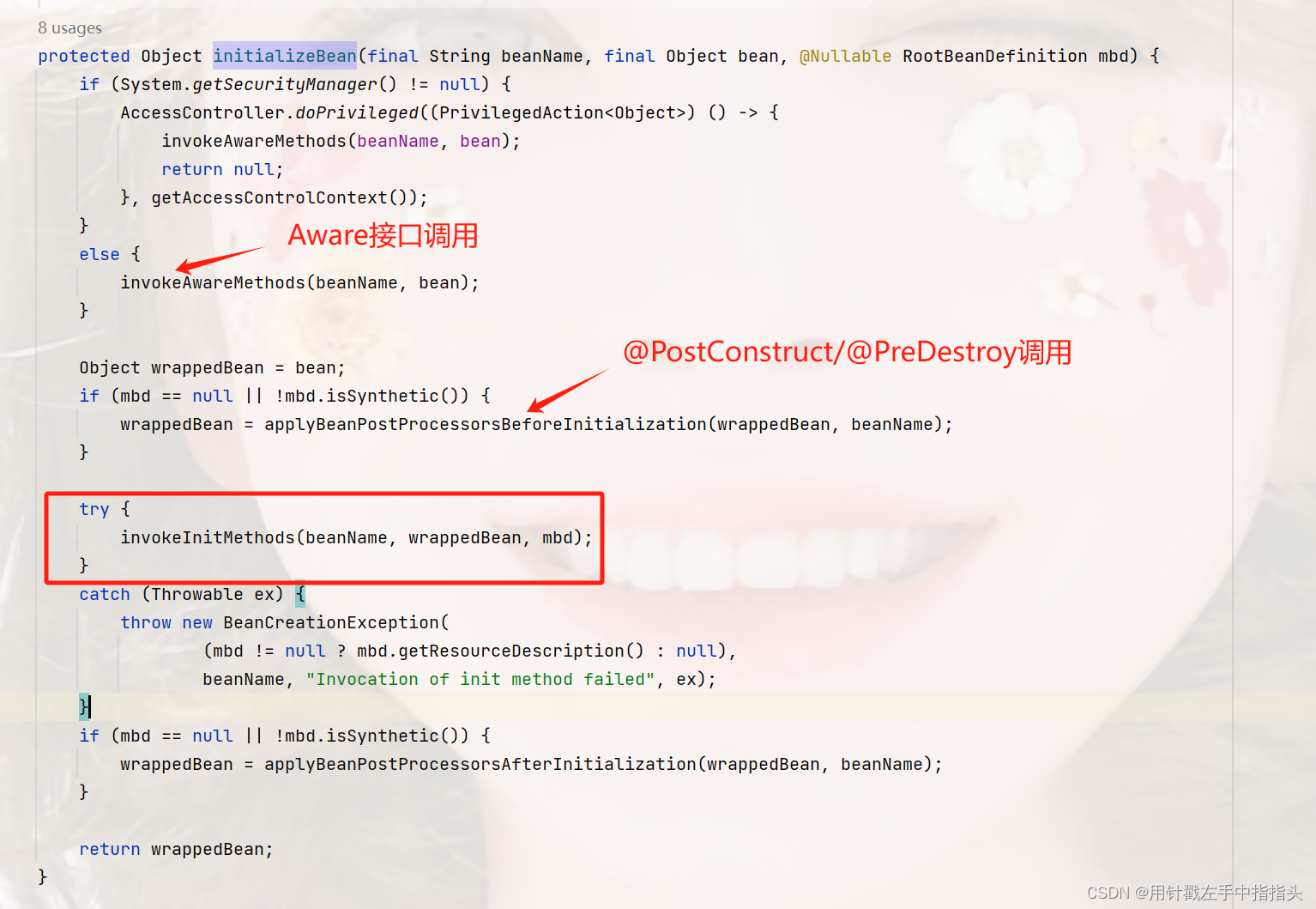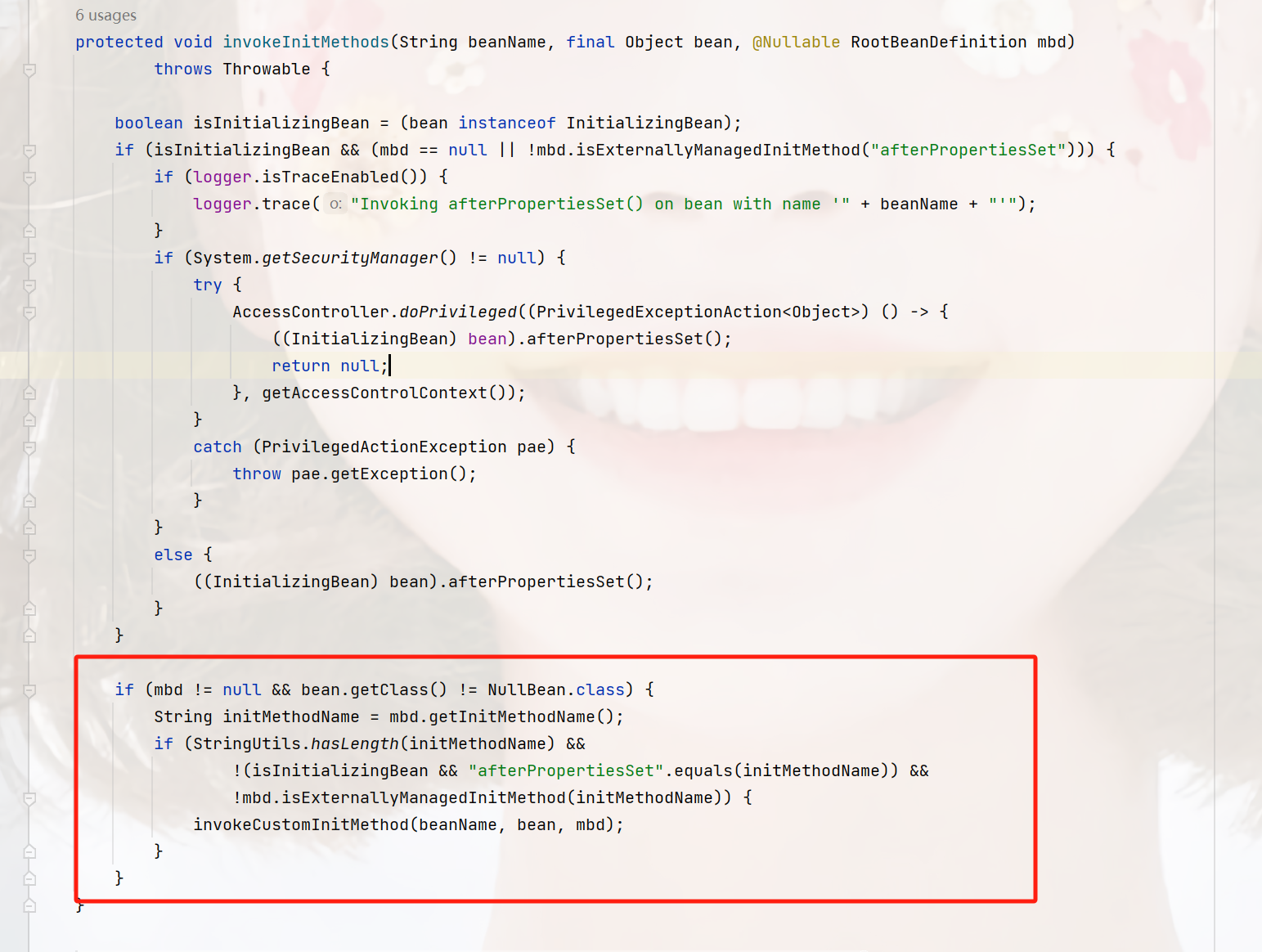功能
之前的文章中由解析过@PostConstruct/@PreDestroy,他们也是initMethod的一种形式,注解方式是后来才加入的,在源码中他们的命名都是一样的名字,都叫initMethod,不过他们却是有着很大的差别,并且他们的执行顺序也不相同,@PostConstruct > afterPropertiesSet >initMethod。
xml配置方式,例如:
<bean id="xx" class="xxxxx" init-method="" destroy-method="">
注解配置
@Component
public class CustomConfig7 {
@PostConstruct
public void t() {
System.out.println("customConfig7 init");
}
@PostConstruct
public void t2() {
System.out.println("customConfig7 init2");
}
@PreDestroy
public void d() {
System.out.println("customConfig7 destroy");
}
@PreDestroy
public void d2() {
System.out.println("customConfig7 destroy2");
}
}
或者是
@Configuration
public class CustomConfig8 {
@Bean(initMethod = "initTest", destroyMethod = "destroyTest")
public CustomTest4 get() {
return new CustomTest4();
}
public static class CustomTest4{
public void initTest() {
System.out.println("init 初始化。");
}
public void destroyTest() {
System.out.println("destroy exec");
}
}
}
而在之前的文章中,还有一种方式,就是手动构建beanDefinition对象,然后手动设置到定义里面,如:
@Component
public class CustomBeanFactoryPostProcessor implements BeanFactoryPostProcessor {
@Override
public void postProcessBeanFactory(ConfigurableListableBeanFactory beanFactory) throws BeansException {
GenericBeanDefinition customBean = new GenericBeanDefinition();
customBean.setBeanClassName(CustomTest4.class.getName());
// 设置初始化方法
customBean.setInitMethodName("initTest");
// 设置销毁方法
customBean.setInitMethodName("destroyTest");
// 设置自定义bean的class
customBean.setBeanClass(CustomTest4.class);
// 设置自动注入
customBean.setAutowireMode(AbstractBeanDefinition.AUTOWIRE_BY_TYPE);
((BeanDefinitionRegistry)beanFactory).registerBeanDefinition("customTestBean4", customBean);
// 提前实例化
Object customTestBean = beanFactory.getBean("customTestBean4");
System.out.println("自定义bean:" + customTestBean);
}
}
这最后这一种方法虽然用不到,但是可以作为了解,可以尝试不一样的方法去完成也是不错的。
源码
同样还是bean初始化方法,位置:
org.springframework.beans.factory.support.AbstractAutowireCapableBeanFactory#initializeBean(java.lang.String, java.lang.Object, org.springframework.beans.factory.support.RootBeanDefinition)


initMethod方法调用和@PostConstruct是并不是同一个入口,它是在afterPropertiesSet方法调用之后执行的。
if (mbd != null && bean.getClass() != NullBean.class) {
// 获取initMethod,
// 就是:customBean.setInitMethodName("initTest");
// 或者:@Bean(initMethod = "initTest", destroyMethod = "destroyTest")
String initMethodName = mbd.getInitMethodName();
if (StringUtils.hasLength(initMethodName) &&
// 这里排除 InitializingBean.afterPropertiesSet 方法
!(isInitializingBean && "afterPropertiesSet".equals(initMethodName)) &&
// 和 @PostConstruct 方法
!mbd.isExternallyManagedInitMethod(initMethodName)) {
invokeCustomInitMethod(beanName, bean, mbd);
}
}
这里的逻辑含义是:
这些初始化回调方法只能执行一次,多次初始化能力赋予,也只能执行一次,且生效的是第一次。
下面进入真正执行的地方:
protected void invokeCustomInitMethod(String beanName, final Object bean, RootBeanDefinition mbd)
throws Throwable {
// 获取设置的initMethod
String initMethodName = mbd.getInitMethodName();
Assert.state(initMethodName != null, "No init method set");
// 获取initMethod的方法对象,因为后面要进行反射操作
// 这里不管它怎么校验,它都能获取私有方法(private)
// 总感觉这有点多此一举,可能我没理解到
Method initMethod = (mbd.isNonPublicAccessAllowed() ?
BeanUtils.findMethod(bean.getClass(), initMethodName) :
ClassUtils.getMethodIfAvailable(bean.getClass(), initMethodName));
if (initMethod == null) {
if (mbd.isEnforceInitMethod()) {
throw new BeanDefinitionValidationException("Could not find an init method named '" +
initMethodName + "' on bean with name '" + beanName + "'");
}
else {
if (logger.isTraceEnabled()) {
logger.trace("No default init method named '" + initMethodName +
"' found on bean with name '" + beanName + "'");
}
// Ignore non-existent default lifecycle methods.
return;
}
}
if (logger.isTraceEnabled()) {
logger.trace("Invoking init method '" + initMethodName + "' on bean with name '" + beanName + "'");
}
// 这个反射工具是获取更加详细的方法信息,
// 如果你的这个初始化方法是一个接口方法,那么他会找到你的接口类,这在后面接口判断中可能会有用
Method methodToInvoke = ClassUtils.getInterfaceMethodIfPossible(initMethod);
// 又是AccessController.doPrivileged ,用于访问特权
if (System.getSecurityManager() != null) {
AccessController.doPrivileged((PrivilegedAction<Object>) () -> {
ReflectionUtils.makeAccessible(methodToInvoke);
return null;
});
try {
AccessController.doPrivileged((PrivilegedExceptionAction<Object>) () ->
methodToInvoke.invoke(bean), getAccessControlContext());
}
catch (PrivilegedActionException pae) {
InvocationTargetException ex = (InvocationTargetException) pae.getException();
throw ex.getTargetException();
}
}
else {
try {
// 一般是走这里的,两边都一样
// makeAccessible 等效于 initMethod.setAccessible(true)
ReflectionUtils.makeAccessible(methodToInvoke);
// 直接反射调用
methodToInvoke.invoke(bean);
}
catch (InvocationTargetException ex) {
throw ex.getTargetException();
}
}
}






















 342
342











 被折叠的 条评论
为什么被折叠?
被折叠的 条评论
为什么被折叠?








